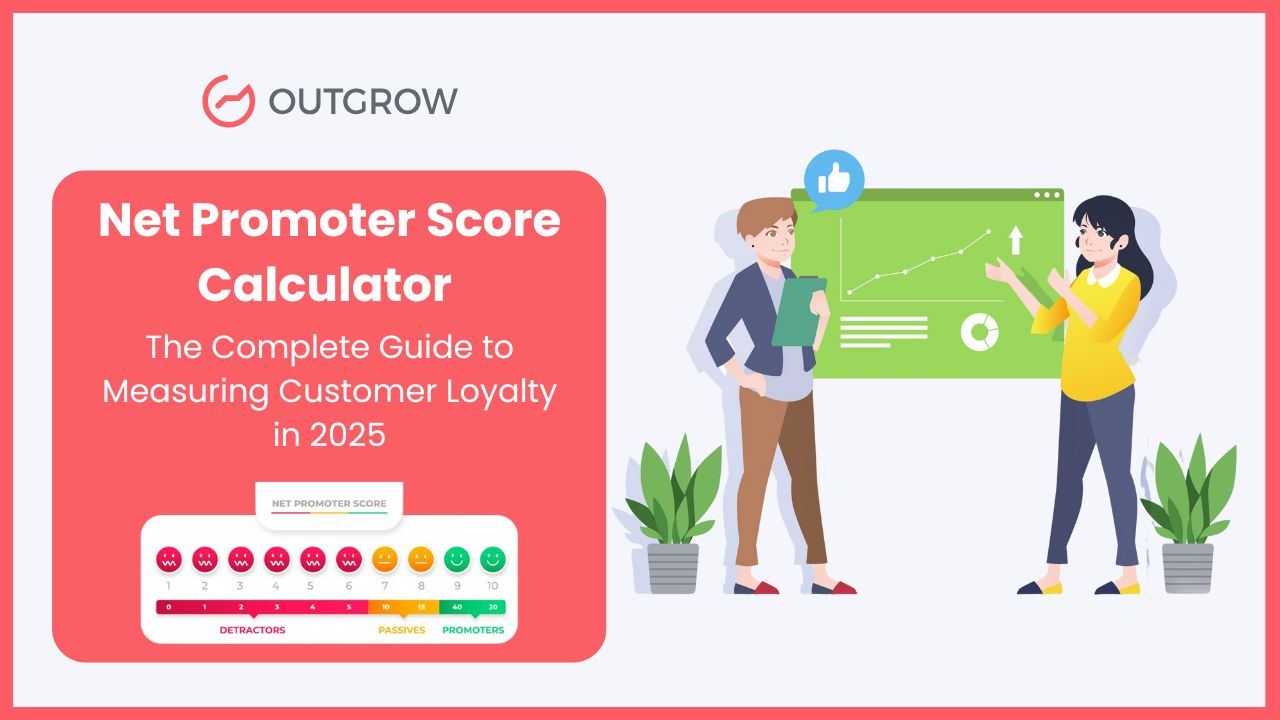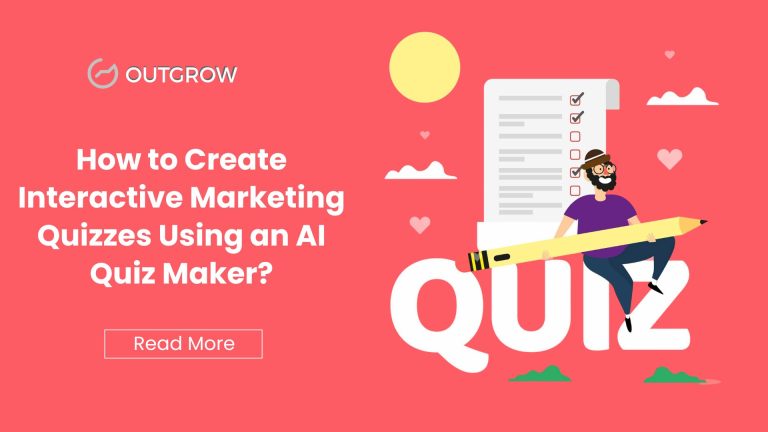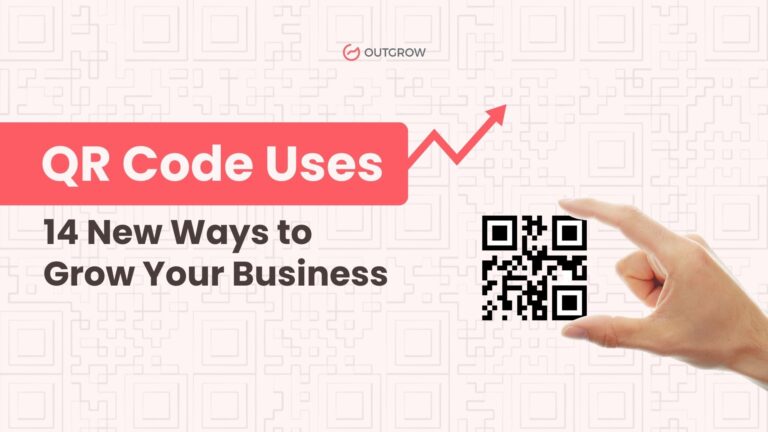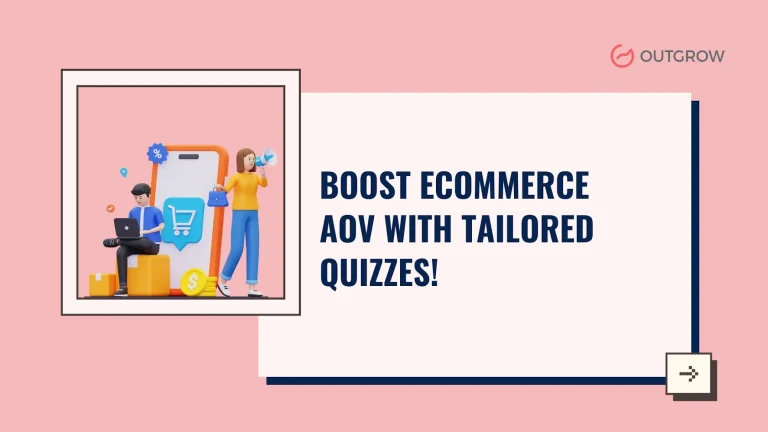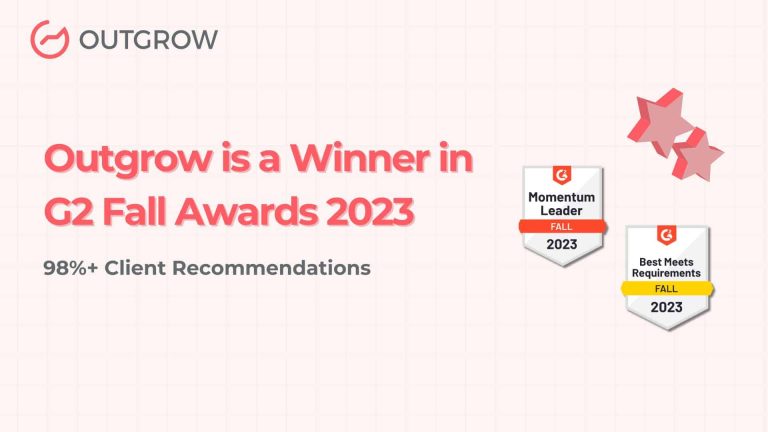Net Promoter Score Calculator: The Complete Guide to Measuring Customer Loyalty in 2025
Table of Contents
Companies lose over $75 billion annually due to poor customer experience. On the other hand, businesses with the highest customer loyalty increase revenues 2.5 times faster than their competitors. The difference? They measure what matters.
Enter the net promoter score calculator – your direct line to understanding customer loyalty. This guide includes everything from basic NPS calculations to advanced implementation strategies that run real business results.
At Outgrow.co, we have helped over 3000 companies create interactive calculators and surveys and generate potential customers. Our NPS calculator templates have processed millions of customer responses, giving us unique insights into what works.
What is Net Promoter Score (NPS)?
Net Promoter Score (NPS) measures customer loyalty through a single, interactive question, such as: “How likely are you to recommend our company to a friend or colleague?” Customers respond on a scale of 0–10, making it the simplest, yet one of the most powerful customer loyalty metrics.
Net Promoter Score Definition
What is NPS exactly? Created by Fred Reichheld at Bain & Company, NPS transforms the complex world of customer satisfaction into one actionable number. Unlike traditional surveys with dozens of questions, Net promoter score gets to the heart of customer loyalty with remarkable precision.
NPS directly measures the possibility of customers marketing your business through reference – the strongest indicator of permanent growth.
Why NPS Matters in 2025
Customer NPS directly correlates with business performance. As a result, companies with scores above 70 often achieve organic growth rates that are 2–3 times higher than their competitors. Here’s the reason:
- Predictive Power: NPS forecasts future revenue growth more accurately than traditional customer satisfaction scores.
- Simplicity: One question generates action-rich insights
- Benchmarking: Industry standards allow competitive comparison
- Cost Efficiency: Reduces the need for complex survey instruments
NPS marketing advantages extend beyond measurement. High NPS scores become powerful marketing assets, building trust with prospects who see real customer advocacy.
Understanding the NPS Score Scale
NPS Score Scale divides customers into three categories based on their 0-10 rating:
Promoters (Score 9-10)
These customers fuel organic growth. They purchase more, stay longer, and refer others. Promoters typically:
- Produce 30-50% more qualified revenue per customer
- Refer 3-5 new customers annually
- Stay with companies five times longer than detractors
Passives (Score 7-8)
Satisfied but not enthusiastic. Passives represent missed opportunities. They:
- Purchase at average rates
- Rarely refer others
- Switch to competitors when better options appear
Detractors (Score 0-6)
Unsatisfied or Unhappy customers who damage business growth through negative words. Detractors:
- Reduce purchase frequency by 20-30%
- Share negative experiences with 10+ people
- Cost companies 2-5x more to retain
How to Calculate NPS: Step-by-Step Complete Guide
The NPS Formula
NPS Score = Percentage of Promoters – Percentage of Detractors
How to calculate NPS in four steps:
- Collect Responses: Survey customers using the standard NPS question
- Categorize Responses: Group by Promoters (9-10), Passives (7-8), Detractors (0-6)
- Calculate Percentages: Divide each group by the total responses you received
- Apply Formula: Subtract detractor percentage from promoter percentage, and you will find the NSP Score
Net Promoter Score Calculation Example
Let’s walk through the NPS score calculation with real data:
Survey Results: 200 total responses
- 80 Promoters (scores 9-10)
- 60 Passives (scores 7-8)
- 60 Detractors (scores 0-6)
Step 1: Calculate percentages
- Promoters: 80/200 = 40%
- Passives: 60/200 = 30%
- Detractors: 60/200 = 30%
Step 2: Apply the NPS calculation formula
- NPS = 40% – 30% = 10
Result: NPS of 10 (most of the industries considered a good score)
How to Calculate Net Promoter Score 10 Point Scale {Guide}
The 10-point NPS scale reveals varying degrees of customer sentiment, from dissatisfaction to loyalty:
Detractors (scores 0–6): Their feedback indicates dissatisfaction and poses a potential churn risk.
- 0-3: Highly dissatisfied, likely to switch immediately
- 4-6: Disappointed, vulnerable to competition
Passives (scores 7–8): These customers are satisfied but not enthusiastic enough to actively promote your brand.
- 7: Satisfied but not excited
- 8: Happy but not passionate advocates
Promoters (scores 9–10): These responses reflect high satisfaction and strong loyalty.
- 9: Very satisfied, likely to recommend
- 10: Extremely satisfied, active advocates
Advanced NPS Calculations
How to calculate eNPS (Employee Net Promoter Score): Apply the same formula to employee satisfaction surveys. eNPS measures employee loyalty and predicts sales risk.
Weighted NPS: Assign customer segments separately based on income contributions or strategic significance.
NPS Calculator Tools & Software
Free NPS Calculator Options
NPS calculator tools streamline the calculation process:
Interactive Online Calculators:
- Outgrow.co’s NPS Calculator: Interactive, embeddable, lead-generating
- Instant results with detailed breakdowns
- Customizable branding, styling, and pre-made templates
- Built-in analytics and reporting for the data
Excel Templates:
- Pre-built formulas for automatic calculation
- Data visualization charts
- Historical tracking capabilities
Google Sheets Solutions:
- Real-time collaboration
- Automatic data imports
- Custom dashboard creation
Standalone Calculators:
- Instant results
- No setup required
- Basic reporting features
Pro Tip: Outgrow.co’s interactive calculators convert 30% better than static forms. Our drag-and-drop builder lets you create branded NPS calculators in minutes, not hours.
Professional NPS Software
NPS software platforms provide comprehensive solutions:
Survey Distribution:
- Email automation
- In-app surveys
- SMS campaigns
- Website widgets
Data Collection:
- Real-time response tracking
- Automated follow-ups
- Multi-channel integration
Analytics & Reporting:
- Trend analysis
- Segmentation tools
- Predictive modeling
- Executive dashboards
Top NPS Survey Software 2025
No-Code Interactive Solutions:
- Outgrow.co: Interactive calculators, surveys, and assessment tools
- Drag-and-drop builder for custom NPS calculators
- Lead generation and CRM integration
- Enterprise Integration, AI-powered insights
- Advanced analytics and conversion tracking
- White-label options for agencies
Enterprise Solutions:
- Qualtrics: An Advanced analytics, enterprise integration
- Medallia: Real-time feedback, AI-powered insights
- CustomerGauge: B2B specialization, account-based tracking
Mid-Market Options:
- SurveyMonkey: User-friendly, affordable pricing
- Typeform: Engaging survey design, mobile optimization
- Zonka Feedback: Multi-channel distribution, automation
Specialized Tools:
- Retently: SaaS-focused, lifecycle automation
- AskNicely: Real-time feedback, team collaboration
- Wootric: In-app surveys, developer-friendly
Choosing the Right NPS Tool
Selection Criteria:
Integration Requirements:
- CRM connectivity (Salesforce, HubSpot)
- Marketing automation (Marketo, Pardot)
- Customer success platforms (Gainsight, ChurnZero)
Survey Capabilities:
- Multi-channel distribution
- Mobile optimization
- Customization options
- Follow-up automation
Analytics Features:
- Real-time reporting
- Trend analysis
- Segmentation tools
- Predictive analytics
Budget Considerations:
- Per-response pricing
- User-based licensing
- Feature tier differences
- Implementation costs
What is a Good NPS Score? {Answer}
A good NSP score is 70 or above (Excellent – World-class performance). Scores of 50–69 indicate Good to Above Average performance, 30–49 indicate Considerable performance with need for improvement, 0–29 are Poor and require immediate action, and scores below 0 are Critical, indicating major issues requiring urgent attention.
A good NPS score depends on industry context and competitive landscape. Here’s the breakdown:
NPS Score Interpretation
Score Ranges:
- 70+: Excellent (World-class performance)
- 50-69: Good (Above average performance)
- 30-49: Acceptable (Room for improvement)
- 0-29: Poor (Immediate attention required)
- Below 0: Critical (Indicate major issues & required immediate action)
Industry Benchmarks 2025
What is a good net promoter score by industry?
Technology Sector:
- Software/SaaS: 61 average
- Hardware: 45 average
- Telecommunications: 34 average
Financial Services:
- Investment/Brokerage: 49 average
- Banking: 34 average
- Insurance: 32 average
Retail & E-commerce:
- Online retail: 45 average
- Department stores: 38 average
- Specialty retail: 42 average
Healthcare:
- Hospitals: 38 average
- Health insurance: 32 average
- Pharmaceutical: 40 average
B2B Services:
- Consulting: 52 average
- Professional services: 48 average
- Construction: 34 average
Context Factors
Company Size Impact:
- Enterprise (1000+ employees): Typically 5-10 points lower
- Mid-market (100-999 employees): Industry average
- Small business (<100 employees): Often 10-15 points higher
Geographic Variations:
- North America: Baseline benchmarks
- Europe: 10-15 points higher on average
- Asia-Pacific: 5-10 points higher
- Latin America: 15-20 points higher
B2B vs B2C Differences:
- B2B scores average 10-15 points higher
- Relationship-based vs transaction-based dynamics
- Longer sales cycles create stronger loyalty
How to Measure NPS Effectively
Survey Design Best Practices
Question Word: “On the scale 0-10, how likely are you to recommend [company name] to a friend or colleague?”
Follow-up Questions:
- “What is the main reason for your score?”
- “What can we do to improve your experience?”
- “What should we do well?”
Response Collection Strategies
Email Surveys:
- Always send within 24-48 hours of interaction
- Use clear, mobile-friendly design
- Include company branding
- Optimize send times (Tuesday-Thursday, 10 AM-2 PM)
In-App Surveys:
- Trigger after key user actions
- Use progressive profiling
- Reduce disruption to user experience
- Provide urgent acknowledgment
Post-Purchase Surveys:
- Time delivery appropriately (1-2 weeks post-purchase)
- Focus on the entire experience, not just the transaction
- Include product and service elements
- Segment by purchase type
Sample Size Requirements
Statistical Significance:
- Minimum 100 responses for basic reliability
- 200+ responses for segmentation analysis
- 500+ responses for advanced analytics
Confidence Intervals:
- 95% confidence level standard
- ±5% margin of error acceptable
- ±3% margin for strategic decisions
Response Rate Optimization:
- Target 15-25% response rate
- Use multiple touchpoints
- Provide incentives when appropriate
- Follow up with non-responders
Advanced NPS Implementation
Integration Strategies
CRM Integration:
- Sync NPS scores with customer records
- Trigger workflows based on scores
- Track score changes over time
- Identify at-risk accounts
Marketing Automation:
- Segment email lists by NPS score
- Create targeted campaigns for each segment
- Automate follow-up sequences
- Personalize messaging based on feedback
Customer Success Integration:
- Alert customer success teams to detractors
- Prioritize outreach based on scores
- Track improvement initiatives
- Measure program effectiveness
Response Protocols
Promoter Engagement:
- Thank customers for positive feedback
- Request referrals or testimonials
- Invitation to customer advisory boards
- Offer exclusive benefits or previews
Passive Cultivation:
- Identify specific improvement opportunities
- Provide additional value or education
- Increase touchpoint frequency
- Monitor for score improvement
Detractor Recovery:
- Respond within 24 hours
- Escalate to the appropriate team member
- Develop specific action plans
- Follow-up to measure improvement
NPS Analytics & Reporting
Trend Analysis
Historical Tracking:
- Monthly score calculations
- Quarterly trend analysis
- Year-over-year comparisons
- Seasonal pattern identification
Cohort Analysis:
- Track customer segments over time
- Identify lifecycle stage impacts
- Measure program effectiveness
- Predict future performance
Segmentation Strategies
Demographic Segmentation:
- Industry vertical analysis
- Company size breakdowns
- Geographic comparisons
- Role-based differences
Behavioral Segmentation:
- Usage level analysis
- Product adoption patterns
- Purchase history correlation
- Engagement frequency
Value-Based Segmentation:
- Revenue contribution analysis
- Lifetime value correlation
- Expansion potential assessment
- Churn risk evaluation
Predictive Analytics
Churn Prediction:
- Identify at-risk customers
- Develop retention strategies
- Prioritize outreach efforts
- Measure prevention success
Revenue Forecasting:
- Correlate NPS with revenue growth
- Predict expansion opportunities
- Assess competitive vulnerability
- Model scenario planning
Common NPS Mistakes & Solutions
Calculation Errors
Formula Mistakes:
- Including passives in the calculation
- Using raw scores instead of percentages
- Applying incorrect weighting
- Mixing different survey periods
Sample Size Issues:
- Insufficient responses for reliability
- Biased sample selection
- Seasonal timing problems
- Channel mixing without adjustment
Survey Design Flaws
Leading Questions:
- Avoid bias-inducing language
- Maintain question neutrality
- Use consistent wording across surveys
- Test questions before deployment
Poor Timing:
- Surveying during customer issues
- Inappropriate frequency
- Ignoring the customer journey stage
- Missing optimal touchpoints
Implementation Challenges
Lack of Action:
- Collecting data without follow-up
- Missing response protocols
- Inadequate resource allocation
- Poor cross-functional coordination
Insufficient Training:
- Teams not understanding the methodology
- Inconsistent interpretation
- Inadequate response handling
- Missing improvement processes
How NPS Compares to Other Customer Metrics
Comparing NPS and Customer Satisfaction (CSAT)
Key Advantages of Using NPS:
- Predictive of future behavior
- Measures emotional loyalty
- Benchmarkable across industries
- Single question simplicity
CSAT Advantages:
- Measures immediate satisfaction
- Evaluates specific interactions
- Easier to improve quickly
- More granular feedback
When to Use Each:
- NPS: Long-term loyalty measurement
- CSAT: Transaction-specific feedback
- Both: Comprehensive customer experience program
NPS vs Customer Effort Score (CES)
Effort Score Focus:
- Measures ease of interaction
- Predicts customer behavior
- Identifies process improvements
- Reduces service costs
Combined Approach:
- NPS for loyalty measurement
- CES for process optimization
- Complementary insights
- Holistic customer experience view
Industry-Specific NPS Strategies
SaaS and Technology
Product-Led Growth:
- Measure feature adoption impact
- Track onboarding success
- Monitor usage pattern correlation
- Identify expansion opportunities
Key Metrics:
- Monthly active users correlation
- Feature usage analysis
- Support ticket correlation
- Renewal rate prediction
E-commerce
Purchase Journey Focus:
- Pre-purchase experience
- Transaction smoothness
- Delivery satisfaction
- Post-purchase support
Optimization Areas:
- Website usability
- Checkout process
- Shipping reliability
- Return policy effectiveness
B2B Services
Relationship-Based Approach:
- Account-level measurement
- Stakeholder-specific surveys
- Project-based feedback
- Long-term partnership focus
Success Factors:
- Service delivery quality
- Account management effectiveness
- Problem resolution speed
- Strategic value provision
Healthcare
Patient Experience Focus:
- Care quality perception
- Communication effectiveness
- Facility and staff experience
- Outcome satisfaction
Compliance Considerations:
- HIPAA requirements
- Patient privacy protection
- Consent management
- Data security measures
Future of NPS Measurement
Emerging Trends
AI-Powered Analysis:
- Natural language processing of feedback
- Automated sentiment analysis
- Predictive modeling enhancement
- Real-time insight generation
Real-Time Feedback:
- Instant survey deployment
- Immediate response analysis
- Dynamic follow-up automation
- Continuous monitoring systems
Technology Integration
Voice of Customer Platforms:
- Multi-channel feedback consolidation
- Unified customer journey mapping
- Cross-functional data sharing
- Integrated action planning
Behavioral Data Integration:
- Combining survey and usage data
- Predictive behavior modeling
- Automated trigger systems
- Personalized experience optimization
Conclusion
The net promoter score calculator converts customer feedback or answers into potential business growth. Companies that master NPS measurement and response see remarkable enhancement in customer retention, revenue growth, and competitive advantage.
Important Implementation Steps:
- Choose Platform: Select Outgrow based on your needs and budget
- Design Your Program: Create research surveys to capture action-rich insights
- Establish Processes: Build a response protocol for each customer section
- Monitor and Improve: Track trends and implement continuous improvements
- Scale Success: Expand measurement across all customer touchpoints
The most successful companies don’t just measure NPS – they work on it. Start with the basics, make systematic processes, and develop your approach based on the result and customer response.
Remember: a good NPS score for your business depends on your industry, customer base, and competitive environment. Be aware of the improvement of the absolute number and use NPS as a basis for deep customer relationships.
Frequently Asked Questions
Net Promoter Score measures customer loyalty through a single question about recommendation likelihood. Therefore, it serves as a valuable tool for strategic decision-making.
Survey customers on a scale of 0 to 10. Next, categorize responses into Promoters (9–10), Passives (7–8), or Detractors (0–6). Finally, subtract the percentage of Detractors from the percentage of Promoters to get your NPS score.
A good net promoter score varies by industry. Technology companies average 61, while banking averages 34. Scores above 50 are considered excellent, 30-49 are good, and scores below 0 require immediate attention.
NPS measures long-term loyalty and the likelihood of recommendation, whereas CSAT focuses on immediate satisfaction with specific interactions.
Measure NPS quarterly for trend analysis, with additional surveys after key customer interactions. Avoid over-surveying – monthly surveys may cause fatigue.
Choose NPS survey software based on your needs: Outgrow Interactive calculators, surveys, and assessment tools, Qualtrics for enterprise analytics, SurveyMonkey for ease of use, or specialized tools like Retently for SaaS companies.
Focus on Detractor feedback first – address their specific concerns and follow up to measure improvement.
eNPS (Employee Net Promoter Score) measures employee loyalty using the same methodology as customer NPS. First, survey employees on their likelihood to recommend your company as a place to work. Then, apply the standard NPS formula to their responses.
Yes, you can calculate NPS with fewer than 100 responses. However, it’s important to note that smaller sample sizes reduce statistical reliability. If you have 50–99 responses, treat the results as directional insights rather than exact measurements.

Ankit Upadhyay is a Digital Marketing and SEO Specialist at Outgrow. With a passion for driving growth through strategic content and technical SEO expertise, Ankit Upadhyay helps brands enhance their online visibility and connect with the right audience. When not optimizing websites or crafting marketing strategies, Ankit Upadhyay loves visiting new places and exploring nature.

